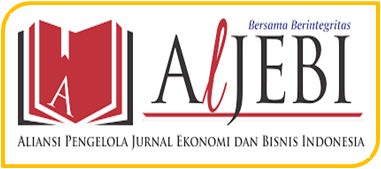INDEKS MAQASHID SYARIAH DAN NILAI PERUSAHAAN BANK UMUM SYARIAH
Abstract
Islamic banks require a different performance measurement than a conventional bank to keep their sustainability. The main disadvantage of employing conventional benchmarks to measure Islamic bank performance is that they fail to investigate shariah facets. This study aims to discover how maqashid shariah index using IMSPM (Integrated Maqashid al-Shariah based Performance Measure) approach and firm value using EVA (Economic Value Added) approach and examine its impact with capital structure on the corporate values of Islamic bank. This study using a quantitative method with the purposive sampling technique. This study involved 11 Islamic bank’s annual reports listed in the Bank Indonesia and OJK from 2015 to 2019 period. The analysis method is multiple linear regression using Eviews 10 program. This study finds that the sample performed highest on the objective of nafs (self) over five-year period. The companies with a constant NOPAT and IC have a better EVA. Maqashid Syariah Index positively influence firm value while the capital structure has no effect.
Keywords
Full Text:
PDFReferences
Analia, A. L., & Anto, M. B. H. (2019). Performance Measurement of Islamic Banking in Indonesia Using the Maqashid Sharia index Method. Proceeding of Conference on Islamic Management Accounting and Economic, 2(1), 235–244.
Ananda, N. A. (2017). Pengaruh Profitabilitas Dan Struktur Modal Terhadap Nilai Perusahaan. Jurnal Ekonomi Dan Bisnis Indonesia, 2(1), 25–31. https://doi.org/10.37673/jebi.v2i1.50
Antonio, M. S., Sanrego, Y. D., & Taufiq, M. (2012). An Analysis of Islamic Banking Performance: Maqashid Index Implementation in Indonesia and Jordania. Journal of Islamic Finance, 1(1), 12–29.
Antwi, S., Mills, E. F. E. A., & Zhao, X. (2012). Capital Structure and Firm Value: Empirical Evidence from Ghana. Internatioanl Journal of Business and Social Sciense, 3(19), 252–261.
Efendi, A. F. W., & Wibowo, S. S. A. (2017). Pengaruh debt to eqruity ratio (DER) dan debt to asset ratio (DAR) terhadap kinerja perusahaan di sektor keuangan yang terdaftar di bursa efek indonesia. Journal of Applied Managerial Accounting, 1(2), 157–163.
Groth, C. J., & Anderson, R. C. (1997). Capital Struture: Perspective for Managers. Management Decision, 35(7), 552–561.
Gupta, R., & Gupta, B. M. (2014). Indian Lymphoma Research : A Scientometric Analysis of Indian Publications Output during 2004-13. Collnet Journal of Scientometrics and Information Management, 8(2), 419–436. https://doi.org/10.1080/09737766.2014.954866
Haniffa, R., & Hudaib, M. (2007). Exploring the ethical identity of Islamic Banks via communication in annual reports. Journal of Business Ethics, 76(1), 97–116. https://doi.org/10.1007/s10551-006-9272-5
Harjito, A., & Martono. (2012). Manajemen Keuangan Edisi Ke-2. Ekonosia.
Harris, M., & Raviv, A. (1979). Optimal incentive contracts with imperfect information. Journal of Economic Theory, 20(2), 231–259. https://doi.org/10.1016/0022-0531(79)90073-5
Hidayat, R., Oktaviani, Y., & Aminudin, A. (2019). Financial Performance of Islamic Banking in Indonesia With Maqasid Shariah Approach. Manajemen Bisnis, 9(1). https://doi.org/10.22219/jmb.v9i1.9442
Hudaefi, F. A., & Noordin, K. (2019). Harmonizing and constructing an integrated maqāṣid al-Sharīʿah index for measuring the performance of Islamic banks. ISRA International Journal of Islamic Finance, 11(2), 282–302. https://doi.org/10.1108/IJIF-01-2018-0003
Istiqamah, M., & Supriyanto, N. (2017). Analisis Struktur Modal Perbangkan Syariah Di Indonesia Tahun 2011-2015. Jurnal Penelitian, 14(2), 201–214. https://doi.org/10.28918/jupe.v14i2.979
Jauziyah, I. Q. (1973). ). I’lamul Muwaqqi’in ’an Rabbil Alamin Editor: Thaha Abdur Rauf Sa’d. Darul Jail.
Lestari, L. (2017). Pengaruh Kepemilikan Institusional Dan Struktur Modal Terhadap Nilai Perusahaan. Jurnal Riset Manajemen Dan Bisnis (JRMB) Fakultas Ekonomi UNIAT, 2(September), 293–306.
https://doi.org/10.36226/jrmb.v2is1.62
Mifrahi, M. N., & Fakhrunnas, F. (2018). Islamic Bank peformance based on Maqasid Based Performance Evaluation Model (MPEM). Jurnal Ekonomi & Keuangan Islam, 4(2), 93–103.
https://doi.org/10.20885/jeki.vol4.iss2.art6
Modigliani, F., & Miller, M. H. (1958). The Cost of Capital, Corporation Finance and the Theory of Investment. The American Economic Review, 48(3), 261–297.
Mohammed, M. O., Razak, D. A., & Taib, F. M. (2008). The Performance Measures of Islamic Banking Based on the Maqashid Framework. IIUM International Accounting Conference (INTAC IV), IV, 2–5.
Mohammed, M. O., & Taib, F. M. (2015). Developing Islamic Banking Performance Measures Based on Maqasid Al-Shari’Ah Framework: Cases of 24 Selected Banks. In Journal of Islamic Monetary Economics and Financem 1(1), 55–77). https://doi.org/10.21098/jimf.v1i1.483
Nizar, M. C. (2016). Literatur Kajian Maqashid Syariah Ulul Albab. Ulul Albab: Jurnal Studi Dan Penelitian Hukum Islam, 35, 53–68.
Ogbulu, O. M., & Emeni, F. K. (2012). Capital Structure and Firm Value: Empirical Evidence from Nigeria. Internatioanl Journal of Business and Social Sciense, 3(19), 252–261.
Otoritas Jasa Keuangan. (2020). https://www.ojk.go.id/Pages/SPS Januari 2020
Padli, M. S., & Diana, N. A. (2019). Pengaruh Good Corporate Governance, Maqashid Sharia, Dan Profitabilitas Terhadap Nilai Perusahaan (Studi Empiris Pada Bank Umum Syariah di Indonesia Periode 2012-2017). E-Jra, 8(1), 1–13.
Panigrahi, S. K. (2017). Economic Value Added and Traditional Accounting Measures for Shareholder’s Wealth Creation. Asian Journal of Accounting and Governance, 8, 125–136. https://doi.org/10.17576/ajag-2017-08-11
Richard, R. (2020). Analisis Pengaruh Profitabilitas, Likuiditas dan Struktur Modal Terhadap Nilai Perusahaan Perbankan yang Terdaftar Di Bursa Efek Indonesia (BEI) Periode 2014-2018. Jurnal Manajemen Bisnis Dan Kewirausahaan, 4(6), 293. https://doi.org/10.24912/jmbk.v4i6.9796
Rohmah, J., Askandar, N. S., & Malikah, A. (2019). Analisis Pengaruh Ukuran Perusahaan dan Kinerja Maqashid Syariah Index Terhadap Nilai Perusahaan (Studi Kasus Pada Bank Umum Syariah Tahun 2013-2017). E-Jra, 08(05), 44–55.
Rosanti, R. A. (2019). Telaah Kinerja Keuangan Perbankan Syariah Dengan Pendekatan Sharia Maqashid Index Di Indonesia. Prosiding Seminar Nasional & Call For Paper, 10, 85.http://jurnal.unmuhjember.ac.id/
index.php/sncp/article/view/1996
Saifi, M., Suhadak, Rahayu, S. M., & Handayan, S. R. (2020). The Effect of Corporate Governance and Investment Opportunity Set on Capital Structure, Dividend Policy, and Firm Performance (A Study on Go-Public Manufacturing Companies in Indonesia Stock Exchange). International Journal of Management and Administrative Sciences (IJMAS), 3(02), 53–63.
Silalahi, M., Komariyah, I., Sari, A. P., Purba, S., Sudirman, A., Nugraha, N. A., & Sulasih, S. (2020). Dasar-Dasar Manajemen dan Bisnis. Yayasan Kita Menulis.
Srikandi, I.P. (2017). Analisis Preferensi Pedagang Pasar Tradisional terhadap Sumber Permodalan dalam Perspektif Ekonomi Islam. repository.radenintan.ac.id
Sriram, G. (1978). Working Capital. Chem Age India, 29(4), 245–251. https://doi.org/10.3390/encyclopedia1030058
Thohuri, R., (2020). Quodavis Bank Banten. https://tangerangexpose.com/
/05/02/dr-rizqullah-thohuri-quovadis-bank-banten/
Khanh, V. T., Hung, D. N., Van, V. T. T., & Huyen, H. T. (2020). A study on the effect of corporate governance and capital structure on firm value in vietnam. Accounting, 6(3), 221–230.https://doi.org/10.5267/
j.ac.2020.3.004
Wahyuni, S., Pujiharto, & Hartikasari, A. I. (2020). Sharia Maqashid Index and Its Effect on The Value of The Firm of Islamic Commercial Bank in Indonesia. Jurnal Riset Akuntansi Dan Keuangan Indonesia, 5(1), 37–45.
DOI: https://doi.org/10.18860/ed.v9i2.11643
Refbacks
- There are currently no refbacks.
Editorial Office:
Megawati Soekarnoputri Building
Faculty of Economics
E-mail: eldinar@uin-malang.ac.id
Universitas Islam Negeri Maulana Malik Ibrahim Malang
E-ISSN 2622-0083

El Dinar under a CC BY SA 4.0 International License.
Member of:
Indexed By:

















